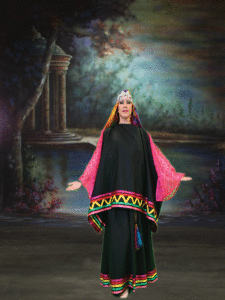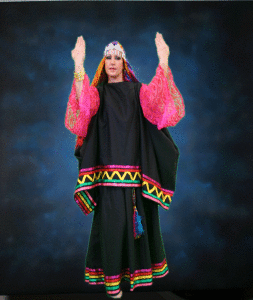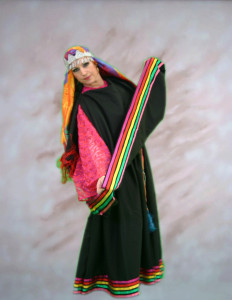
 Chaoui Berber
Chaoui Berber
(Algerian near the border of Tunisia)
Every year in springtime the Chaoui Berber celebrate in the region of Arris (Atlas Mountain Aures) a fertility fest called Bendou and during this fest, the young girls dance Abdaoui. This dance is based on a historical legend: A long time ago there lived a very generous old man and he owned one fig tree and he allowed everyone that came there to decorate this tree. After he died, they claimed him as a holy man and buried him beneath this tree. Each year they honored him as a Marabou (Saint). The village people remembered and honored him every spring when nature gives its fruit.
They decorate the tree with precious food. The tree eventually dried out and died but the tradition stayed preserved. Today the fig tree is replaced with a tree log also called the Bendou. Everyone in the village brings their share of figs, dates, etc., and take it to the house of the oldest member of the village and they decorate the tree together. They sometimes add branches to add more fruit if necessary.
The fest begins with a procession from where it is decorated and ends in the village square. Two women are in front of the procession and they sprinkle salt to symbolize the chasing away of bad ghosts or spirits as the men behind them carry the tree log, Bendou to the village square.
 The other women sing and are accompanied by musicians and the village men. When they reach the city square, the oldest man takes one date or piece of fruit from the Bendou and gives it to a girl who is engaged to be married to symbolize the fertility for the coming year. The young women wear long black dresses and a wide colored shawl from light color wool. On their heads they tie many colored scarves. They wear their best silver jewelry that is accompanied by colorful coral, which is typically worn in this region. It is also their favorite stone. They also wear bracelets, small chains with hanging decorations on it, hoop earrings, and fibula to hold the fabric together (like the Tunisian Melia).
The other women sing and are accompanied by musicians and the village men. When they reach the city square, the oldest man takes one date or piece of fruit from the Bendou and gives it to a girl who is engaged to be married to symbolize the fertility for the coming year. The young women wear long black dresses and a wide colored shawl from light color wool. On their heads they tie many colored scarves. They wear their best silver jewelry that is accompanied by colorful coral, which is typically worn in this region. It is also their favorite stone. They also wear bracelets, small chains with hanging decorations on it, hoop earrings, and fibula to hold the fabric together (like the Tunisian Melia).
Music consists of a large drum (like Turkish or Ghawazii drum) and flute (ghaita). The girls dance Abdaoui in pairs to an 12/8 rhythm with small quick steps. They make small turns while moving around the Bendou and appear to glide. They also dance back to back while stamping with one foot to keep time while their ankle bracelets (Khalkhal) make a tinkling sound. The upper body is held straight and it never interferes with the elegance of the dance.
 They hold on to their dresses between two fingers i.e., thumb and index finger that make it appear as if they have wings. With this gesture, they give thanks to the name H’djilette (plural for Pheasant) – they look like two flying birds. (H’ajal means Pheasant singular). At the end of this celebration they all sit together and eat, this is called (Zerda).
They hold on to their dresses between two fingers i.e., thumb and index finger that make it appear as if they have wings. With this gesture, they give thanks to the name H’djilette (plural for Pheasant) – they look like two flying birds. (H’ajal means Pheasant singular). At the end of this celebration they all sit together and eat, this is called (Zerda).
Other styles and figures in the dances of Chaoui are found in dance styles of the Sahli, Archaoui, Redakhi, Talhit, but the dance of the Abdaoui is mostly found in the region of d’Arris, Batna, Oued Abdi, M’chounech
References: Mustapha El Oueslati, [email protected], Khadejah El Oueslati, [email protected], Spektrum Orientalischer Tanz bei Nabila Shams El Din dtd April 2004, Buch #10.20.068, nabila-shams-el-din.de/Professor Hedi El Cheriffa, Leon, France/Danses du Maghreb d’une rive `a l’autre, Editions Karthala, 1987/Halima B20644F, 2nd Quartal 2003
